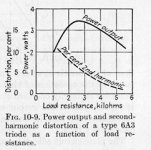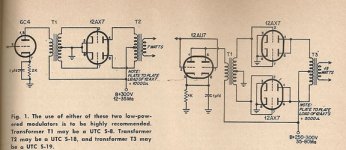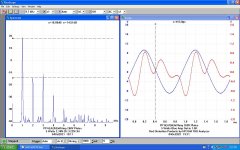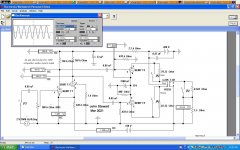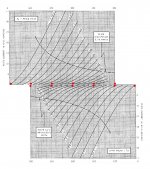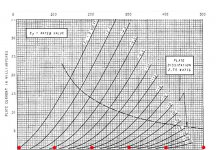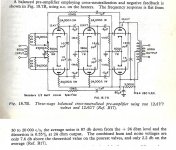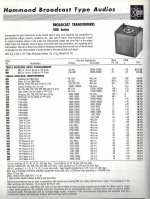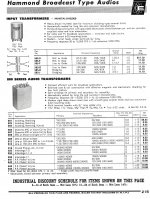That looks a lot better, 3dB point looks to be well below 100Hz and Hammond only specs it for 150Hz anyway. I still think it would be worthwhile for someone to actually measure the inductance of a 125 at 20Hz because then the sim would be more realistic.Hammond 125A is much better for low power / high impedance application. It has 15 H primary and sufficient power capacity.
Attached the simulation with 125A at 11.6k to 8 ohms. Output level >600 mW.
Cheers
Ian
If you look at this Brimar datasheet for the 12AU7 you will see it recommends either 10K or 15K anode to anode impedance. Maybe this will mitigate the lack of bass issue.
Cheers
Ian
Lots of distortion, predominately 3rd Harmonic. But typical of driving a 10K load from a triode source of about 15K. Doesn't anyone check the old electronic text books anymore?
PP 12AU7 makes a good modulator for a low power transmitter. But not HIFI. Same goes for a PP 12AX7.
Attachments
If you look at this datasheet:Lots of distortion, predominately 3rd Harmonic. But typical of driving a 10K load from a triode source of about 15K. Doesn't anyone check the old electronic text books anymore?
PP 12AU7 makes a good modulator for a low power transmitter. But not HIFI. Same goes for a PP 12AX7.
https://frank.pocnet.net/sheets/184/1/12AU7.pdf
you will see that with a 10K anode to anode load the 12AU7 produces about 1.5% 3rd harmonic at 500mW output. It was widely used i this configuration in am and fm radio broadcast mixers from the 50s onwards. Their main requirement is to be able to output +26dBm (400mW) into a 600 ohm load but their normal operating level was typically +8dBm or +18dBm at which levels the distortion would have been much lower.
I agree it is not hifi; all I was attempting to do was to help the OP improve his existing design. The 12AU7 would be my last choice for any part of a high quality audio chain since its intrinsic distortion is known to be higher than almost any other small triode.
Cheers
Ian
I'm scratching my head about that claim of seven watts from a 12AX7 🙄...
Best regards!
Thats running Class B in a Ham TX in intermittent service. They don't try to reduce D% at all. Even before the signal gets to that point its probably gone thru a speech clipper too. And they exaggerate a lot, just like we do with our muscle cars!!😀
NB FM does much better but uses more spectrum. Oh Dear!🙂
Last edited:
If you look at this datasheet:
https://frank.pocnet.net/sheets/184/1/12AU7.pdf
you will see that with a 10K anode to anode load the 12AU7 produces about 1.5% 3rd harmonic at 500mW output. It was widely used i this configuration in am and fm radio broadcast mixers from the 50s onwards. Their main requirement is to be able to output +26dBm (400mW) into a 600 ohm load but their normal operating level was typically +8dBm or +18dBm at which levels the distortion would have been much lower.
I agree it is not hifi; all I was attempting to do was to help the OP improve his existing design. The 12AU7 would be my last choice for any part of a high quality audio chain since its intrinsic distortion is known to be higher than almost any other small triode.
Cheers
Ian
But many of those on this forum are looking for something better. Somewhere on the forum a while back Lingwendil had a thread going to achieve something similar to the OP. I got involved, I had the same concerns as here. Along the way I built & thoroughly bench tested four different tubes in PP. They are 6SN7, 6BL7, 6BX7 & 5998. All these have the same pinout, is was no problem to simply run these tests in groups while changing the cathode resisters. Max power in Class A varied from One to 10W. All of the resulting tests results are in that thread complete with waveforms & distortion spectrums. Just need to find the thread.
Curvature in the plate family causes 2H in a SET amp that becomes 3H in a PP amp.🙂
Excellent work. It is clear there are some interesting double power triodes in octal bases.Somewhere on the forum a while back Lingwendil had a thread going to achieve something similar to the OP. I got involved, I had the same concerns as here. Along the way I built & thoroughly bench tested four different tubes in PP. They are 6SN7, 6BL7, 6BX7 & 5998. All these have the same pinout, is was no problem to simply run these tests in groups while changing the cathode resisters. Max power in Class A varied from One to 10W. All of the resulting tests results are in that thread complete with waveforms & distortion spectrums.
The 6SN7 and 6BL7 are both unsuitable because they suffer from the low transconductance and/or low mu that gives rise to a high ra (just as in the 12AU7) which is exactly what you do not want. If I were to design a small signal tube PP amp I would start with something like the ECC88 with its 2K ra
I am not quite sure what you are saying but triodes produce more 2H than any other harmonic. However, in a PP topology, all even harmonics starting with 2H are more or less cancelled by the PP action. The most significant harmonic remaining is thus 3H.Curvature in the plate family causes 2H in a SET amp that becomes 3H in a PP amp.🙂
Cheers
Ian
I am not quite sure what you are saying but triodes produce more 2H than any other harmonic. However, in a PP topology, all even harmonics starting with 2H are more or less cancelled by the PP action. The most significant harmonic remaining is thus 3H.
Cheers
Ian
I've been meaning to construct a graphical method to shew that for a while now. But it is Fall here in the Great White North adjacent to the Big Smpke (Toronto), I'm running hard to get this 4.4Acres (2Hect) ready for Winter. Good weather but cool this week, a small amount of snow in the forecast. So it will be a week before I can make any headway with serious electronics.
My most recent project is an experimental PP 6EA7/6EM7 amp. It clips at about 7W. The test results are very good.🙂
Many experimental amps on the shelf here. Not sure what to do with them, now at 89 yrs.🙂
Cheers
Ian
I've been meaning to construct a graphical method to shew that for a while now. But it is Fall here in the Great White North adjacent to the Big Smpke (Toronto), I'm running hard to get this 4.4Acres (2Hect) ready for Winter. Good weather but cool this week, a small amount of snow in the forecast. So it will be a week before I can make any headway with serious electronics.
My most recent project is an experimental PP 6EA7/6EM7 amp. It clips at about 7W. The test results are very good.🙂
Many experimental amps on the shelf here. Not sure what to do with them, now at 89 yrs.🙂
Attachments
Just for comparison. This datasheet for the ECC40 (mu = 32, S = 2.9 mA/V) contains data and a graph for use as a class A push-pull amplifier (Raa = 30K, Po = 520 mW at 1% distortion): http://www.r-type.org/pdfs/ecc40.pdf
I think that the "low mu" part is a typo and should be "high mu".
The 6SN7 and 6BL7 are both unsuitable because they suffer from the low transconductance and/or low mu that gives rise to a high ra (just as in the 12AU7) which is exactly what you do not want.
I think that the "low mu" part is a typo and should be "high mu".
Ruffrecords, I was thinking about 12B4 for this application but I had totally forgotten about the ECC88. Very intriguing if high gm oscillation issues can be dealt with. Hmm...
The 12B4 is an interesting valve. Over 5W plate dissipation and ra of about 1K. It has a reasonably high gm at 6.3 so a grid stopper would be advisable
ECC88 has a plate dissipation about half that of the of the 12B4 and its plate resistance is around 2K. I use them all the time in line amps configured as an SRPP output stage coupled with half an 12AX7 with 20dB of overall NFB. This will drive 200 to 400mW into any load via a suitable transformer at reasonably low distortion. A particular advantage is that you do not need a phase splitter and you can use an ungapped transformer for better bass response.
Cheers
IAn
ECC88 has a plate dissipation about half that of the of the 12B4 and its plate resistance is around 2K. I use them all the time in line amps configured as an SRPP output stage coupled with half an 12AX7 with 20dB of overall NFB. This will drive 200 to 400mW into any load via a suitable transformer at reasonably low distortion. A particular advantage is that you do not need a phase splitter and you can use an ungapped transformer for better bass response.
Cheers
IAn
Excellent work. It is clear there are some interesting double power triodes in octal bases.
The 6SN7 and 6BL7 are both unsuitable because they suffer from the low transconductance and/or low mu that gives rise to a high ra (just as in the 12AU7) which is exactly what you do not want. If I were to design a small signal tube PP amp I would start with something like the ECC88 with its 2K ra
I am not quite sure what you are saying but triodes produce more 2H than any other harmonic. However, in a PP topology, all even harmonics starting with 2H are more or less cancelled by the PP action. The most significant harmonic remaining is thus 3H.
Cheers
Ian
Here is the real answer for all to see. Looking at the 12AU7 plate family we see that the grid voltage curves are closer together at the RHS of the graph than at the LHS. This is the prime source of even order harmonics (2H, 4H, 6H.....), It is also the reason that as signal increase the DC plate current also increases. Some people call this rectificationThatIt is also the Zeroith Harmonic, just another even order harmonic in the Fourier Series created by operation of the tube.
By rotating (not inverting) the plate family & lining the result up with the original we have the composite family, the push-pull version. We can construct on this any loadline we like as long as it passes thru 300V on this example. Other constructions for other operating plate voltages are possible.
The same grid voltages are still squeezed as before but they are now at the center of the loadline. So Odd Order Harmonics a caused by the same triode property as in the SE case.😀
Everybody got that? There might be a test after this!😱
Attachments
Last edited:
!2AU7 used in Broadcast Line Amp
Lifted from RDH4. Uses low noise 12AY7s in the front end.
The Hammond 900 & 800 Series had/has transformers used in BC work.
Very quiet here for a few days. Everyone gone?🙂
Lifted from RDH4. Uses low noise 12AY7s in the front end.
The Hammond 900 & 800 Series had/has transformers used in BC work.
Very quiet here for a few days. Everyone gone?🙂
Attachments
THat is very much the kind of thing I had i mind when I said I had seen PP 12AU7 stages in broadcast mixers from the 40s/50s.
Yes, it has been quiet lately. No idea why. Lots of talk about retirement though in the lounge.
Cheers
Ian
Yes, it has been quiet lately. No idea why. Lots of talk about retirement though in the lounge.
Cheers
Ian
THat is very much the kind of thing I had i mind when I said I had seen PP 12AU7 stages in broadcast mixers from the 40s/50s.
Yes, it has been quiet lately. No idea why. Lots of talk about retirement though in the lounge.
It's also getting through seasonal duties - family stuff etc although it does concern me that compared to 2010 it seems quieter.
Perhaps people feed they've said everything that needs saying about tubes 😉
I'm taking a shot at a mini stereo amp. Per-channel it uses 2 dual triodes to make the PI (12AX7) and output (12AU7) stages. I'm using a cheap $5 PA matching transformer for the output transformer. A couple cheap 12vac transformers will make my power transformer. I'm stepping 120 down to 12 to grab heater power then stepping 12 back up to 120 with the second transformer. A voltage doubler provides me about 300vdc. My output transformer has an 8-ohm secondary and quite a few taps on the primary.
0
62.5
125
250
500
1000
2000
4000
8000
I'll use the 4000 for my center tap and 0 and 8000 for the 2 phases. B+ will be around 225~275v to the 12AU7 and 200v to the PI.
Here's a pic of the single-ended monstrosity I built just to try it. The power stage is a parallel 12AX7 and one side of another 12AX7 for a preamp. No Criticism! I'm still on my learning curve. 😀
I've seen a design like this somewhere online but I can't find it. Anyone have it?
SRPP+ PCB & User Guide
Design is a high impedance headphone amplifier. I'm using it as a driver.
- Home
- Amplifiers
- Tubes / Valves
- 12AU7 / 12AX7 push-pull
